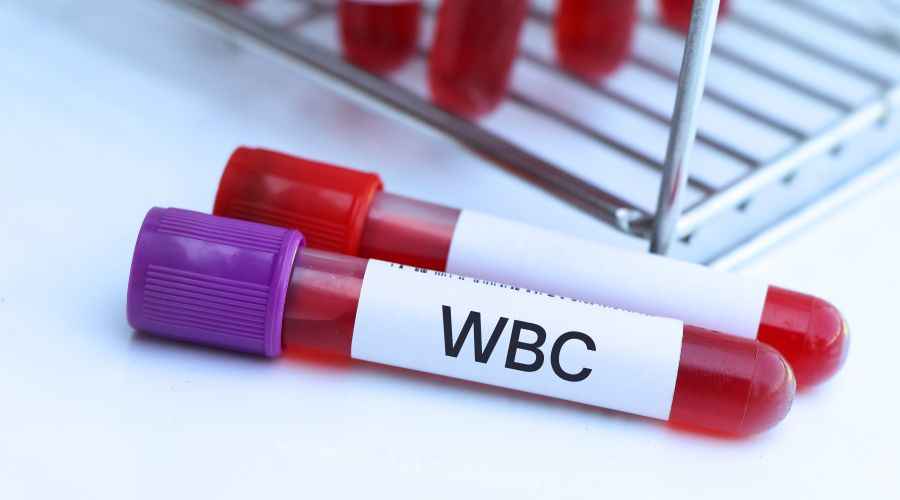How to Increase WBC Count? Its Types, Normal Range, & Tips

Medically Reviewed By
Dr Divya Rohra
Written By Komal Daryani
on Jun 5, 2024
Last Edit Made By Komal Daryani
on Jul 19, 2025

Did you know that you have a whole army of soldiers inside your body fighting to protect it from diseases? That’s right! White blood cells in our body act as defense mechanisms to tackle and eliminate any potential threats our body faces. The immune system comprises different types of WBCs, which play a role in detecting, blocking, and destroying various foreign pathogens and organisms that enter our body. You must be curious to know more about these tiny soldiers, so dive into this article that will walk you through everything you need about WBCs.
Why are WBCs Important?
White blood cells are crucial for you as they protect the body against infections and foreign pathogens. They travel through your tissues and bloodstream, identify and locate unknown organisms to fight them off. White blood cells fight off foreign invaders by producing antigen proteins, which attach to the pathogen and explode, destroying it.
Types and functions of WBCs
Different types of white blood cells exist in our body and carry out other functions. Each type of WBC has its importance. Here are the various types of white blood cells:
Neutrophils
Neutrophils are the most common type of white blood cells, comprising 50-70% of all WBCs.They are responsible for locating and fighting off bacterial infections. Neutrophils work by setting traps for pathogens and ingesting them to destroy them. Your body may show signs like redness and swelling during this process.
Basophils
Basophils are another type of white blood cell, comparatively smaller in number, about 0.5-1% of all WBCs. They also eliminate bacterial infections, allergens, parasites, and blood clottings. The difference between Neutrophils and Basophils is that the latter does not recognize agents it had previously encountered as a danger to the body. They attack unfamiliar foreign pathogens by surrounding and ingesting them.
Eosinophils
Eosinophils are similar to neutrophils and basophils in their function of destroying foreign pathogens. However, these white blood cells are a bit special. They contain small sand-like granules that release a toxic protein to destroy the pathogens. Eosinophils comprise 1-4% of the total WBCs in our body.
Monocytes
Monocytes are large white blood cells that can be further divided into two categories- dendritic cells and macrophages. Dendritic cells are the informers of foreign invasion. They alert other cells to fight the incoming foreign pathogens. Macrophages are the front-line soldiers. They reach the location of invasion and destroy germs and other pathogens by surrounding and ingesting them. Monocytes comprise 2-8% of the total WBCs.
Lymphocytes
Lymphocytes are the second most common type of WBCs, comprising 20-40% of your total white blood cells. They help your immune system remember all previously encountered pathogens. Lymphocytes can be divided into two categories- B cells and T cells. B cells produce antibodies and ingest pathogens, while T cells help destroy cancerous and infected cells to prevent the infection from spreading.
Seven ways to increase your WBC count
- WBC Boosting Foods
Eating nutritious foods rich in Vitamins, minerals, and fiber helps increase your WBC count naturally and strengthen your immune system. Here are some foods you can consume to boost your WBC count:
- Citrus fruits: Vitamin C is known to increase your WBC production. However, it is not produced in the body, and you must fulfill your Vitamin C needs through your diet. Citrus fruits have high amounts of Vitamin C and other nutrients, which help boost your WBC count.
- Garlic has antimicrobial properties and is rich in sulfur. It is quite effective against infections and also increases the WBC count.
- Lean Meats: Protein is crucial for the development of WBCs. Lean Meats contain high amounts of protein and can provide all essential proteins required for WBC production.
- Yogurt is a rich source of probiotics. Probiotics help strengthen the gut health and fight off bad bacteria. This can minimize the loss of excess WBCs, hence promoting WBC count.
- Seafood: Various types of seafood, such as salmon, oysters, crabs, shellfish, etc., contain omega-3 fatty acids and zinc, which are known for boosting WBC count. Omega-3 helps in the production of phagocytes, a type of WBC, while zinc is known to promote the motility and count of WBCs.
Also Read: Foods to Increase White Blood Cells
- Healthy Sleep Cycle
Sleep is the body's restoration time. The body repairs itself and produces new cells and tissues, replacing older ones, including WBCs. Improper sleep patterns and lack of sleep can weaken your immune system. A regular sleep schedule can help strengthen your immune system and increase WBC production. Having at least 7-8 hours of quality sleep daily is important.
- Staying Hydrated
A hydrated body is a healthy body. Water is used for routine cleansing through sweat and urine excretion. It is also important for the production of WBCs. Dehydration can cause a low blood volume, disrupting the flow of WBCs through blood vessels. Hence, it is important to stay hydrated throughout the day.
- Minimize Stress
Mental and physical stress contributes to a weakened immune system. Increased stress levels result in the excessive release of stress hormones and hinder the production and function of WBCs. Controlling stress levels can also lead to an improved mental state and lifestyle. Minimal stress levels improve overall health and boost WBC count.
- Take Supplements
Aside from a balanced diet, you can take several supplements to increase your WBC count. Taking supplements containing multivitamins such as Vitamin A, B6, B12, C, etc can be beneficial for WBC count. Supplements with zinc, folate, selenium, etc., can also boost your WBC production. If you cannot get enough of these supplements through your diet, consider taking supplements.
- Lifestyle changes
Certain lifestyle factors contribute to a lower WBC count. Habits such as smoking and excess alcohol consumption can hurt WBC count. They can decrease the production and function of WBCs and harm our immune system. Simple personal hygiene habits like frequent hand washing and maintaining body hygiene can help eliminate and minimize exposure to germs and other pathogens.
- Regular medical checkups
As important as it is to follow dietary and lifestyle changes, it is equally necessary to be knowledgeable about your health and to stay updated with your medical conditions. Regular health checkups and tests help prevent diseases and control the development of any abnormalities or complications. Regular consultation with medical professionals can also help you stay informed about your health.
What is the normal range for WBC count?
White blood cells comprise around 1% of our blood cells. They are a crucial component of our immune system and play a major role in fighting infections and foreign pathogens. The amounts of white blood cells may vary due to multiple reasons. Here are the various ranges of WBCs :
Normal WBC
Normal white blood cell counts can vary with different laboratories and individual factors. A normal WBC count ranges between 4500 and 11000 WBC per microfilter. Normal ranges can vary due to several factors, including age, sex, race, and individual medical conditions. Here is a list of normal WBC levels according to different age groups :
|
Age Group |
WBC Count |
|
0-2 weeks old |
9,000 to 30,000 cells/mm3 |
|
2-8 weeks old |
5,000 to 21,000 cells/mm3 |
|
Two months - 6 years old |
5,000 to 19,000 cells/mm3 |
|
6 -18 years old |
4,800 to 12,800 cells/mm3 |
|
Adults |
4,500 to 11,000 cells/mm3 |
Low WBC
A low WBC count is when there are less than 4000 cells of WBCs per microfilter of your blood. Although WBCs can rise and fall occasionally, the problem arises when the WBCs fall and do not rise. This condition is called leukopenia, characterized by a sharp decrease in WBCs. Here are some common causes of low WBCs or Leukopenia:
- Infections
- Bone Marrow problems
- Autoimmune Disorders
- Medicines
- HIV
- Spleen problems
High WBC
A high white blood cell count can indicate an infection, inflammation, or injury. However, a prolonged high WBC count may indicate cancer or bone marrow problems. More than 11000 WBC cells per microfilter of blood is considered a high WBC count. A persistent high WBC count is referred to as Leukocytosis. Some common causes of this condition include:
- Excessive stress
- Infections
- Obesity
- Smoking
- Splenectomy
- Thyroid Problems
Also Read: WBC Count: Normal Range of WBC, When is it Abnormal?
What are the tests for WBC?
Your white blood cell counts are generally measured through blood tests. These blood tests can provide details of your total WBC count, a count of different types of WBCs, and other parameters concerning WBCs. Here are some common WBC tests:
CBC Test
A CBC, or complete blood count test, measures the amounts of red blood cells, hemoglobin, platelets, and white blood cells, among other things. This test provides an overview of your blood cell level and helps identify disorders such as leukemia and anemia.
DLC Test
The DLC(Differential Leukocyte Count) test is a blood test used to measure the count of different types of WBCs separately. This test helps diagnose the decrease or increase in a particular kind of WBC and specific conditions related to it. An increase in one or more distinct types of WBCs may indicate certain chronic conditions or infections.
LAD Test
The LAD( Leukocyte Adhesion Deficiency) test is used to diagnose Leukocyte Adhesion Deficiency, an immunodeficiency disorder in which T cells and B cells become impotent and fail to locate or reach the infection site and destroy pathogens.
Disorders linked with WBC count
White blood cells and their production is crucial for our immune system and overall health. An increase or decrease in WBC count can cause certain disorders. Here are the disorders linked with WBC count:
Leukocytosis
Leukocytosis is characterized by a high white blood cell count, which may occur for several reasons, including Leukemia. It may also be caused by severe infections or inflammation in the body. There are different types of leukocytosis based on various WBCs:
- Neutrophilia: Characterized by an excessive increase in Neutrophils, a type of WBCs that fight infections.
- Monocytosis refers to excessive amounts of monocytes in the bloodstream, WBCs that boost immune system responses.
- Basophilia is a rare condition that increases Basophils, the most uncommon type of WBCs that prevent blood clotting and fight parasitic infections.
- Eosinophilia: A common condition characterized by excessive Eosinophils, WBCs that fight allergies and autoimmune disorders.
- Lymphocytosis: Lymphocytes are WBCs responsible for protecting your lymphatic system. A high amount of these WBCs causes Lymphocytosis.
A total WBC count of more than 11000 cells/mm3 can indicate Leukocytosis. Your healthcare provider may treat this disorder according to the factors that caused it.
Leukopenia
A severe lack of white blood cells can give rise to a disorder called Leukopenia. Leukopenia arises when your WBC count is less than 4000 cells/mm3 and may cause serious complications. This disorder may be caused by lifestyle factors such as smoking and alcohol consumption or poor dietary habits, leading to vitamin and mineral deficiency. It may also be caused by certain bone marrow disorders, such as
Aplastic anemia and Multiple myeloma. Autoimmune diseases such as Lupus and Arthritis may also cause this condition.
Can Medicine increase white blood cells?
Yes, certain medicines can help increase white blood cell (WBC) count, especially in cases where levels are low due to infections, chemotherapy, or other medical conditions. Some of the commonly used medications include Filgrastim, Pegfilgrastim, Sargramostim. These drugs facilitate the bone marrow to produce more WBCs, particularly neutrophils, and are commonly used for chemotherapy-induced neutropenia. If you or someone you know has low WBC counts, it’s essential to consult a doctor before taking any medication.
What causes low White blood cell counts?
Low WBC count, also known as leukopenia, can be caused by various factors including medical health issues, lifestyle factors, and treatments. Here are some common causes.
Medical conditions
- Viral infections like flu, HIV, hepatitis, or dengue
- Autoimmune disorders like lupus, rheumatoid arthritis, or Sjögren’s syndrome
- Bone Marrow Disorders like leukemia, aplastic anemia, or myelodysplastic syndromes
- Nutritional Deficiencies like lack of vitamin B12, folic acid, copper, or zinc
- Cancer & Chemotherapy
- Severe Infections (Sepsis)
Lifestyle & Environmental Factors
- Chronic Stress
- HIV/AIDS
- Drug exposure
- Malnutrition & Poor Diet
- Excessive Alcohol Consumption
Symptoms of Low WBC
A low white blood cell or WBC count, or leukopenia, weakens the immune system, making the body more vulnerable to infections. The symptoms may vary based on the severity and underlying cause. Here are some common symptoms of Low WBC, including-
- Frequent Infections like cold, flu, or bacterial infection
- More frequent respiratory infections (pneumonia, bronchitis)
- Fever & chills
- Constant tiredness and low energy
Sore throat & mouth ulcers - Painful throat without any known cause
- Ulcers or white patches in the mouth (signs of infection)
- Increased skin infections (boils, rashes)
- Redness, swelling, or pus formation in wounds
- Digestive Issues
- Frequent diarrhea or loose stools
- Stomach pain and discomfort
- Nausea or vomiting due to infections
- Easy bruising with minor injuries
- Bleeding gums or nosebleeds
- Joint & muscle pain
If you experience these symptoms frequently, get a WBC test and consult your doctor for proper evaluation and treatment.
When Should You Get a WBC Test?
You should take a WBC Test if you are-
- If you have frequent infections, fatigue, fever, or unexplained bruising
- To monitor immune system health
- As part of routine health checkups
- If you have blood-related disorders
- If you are undergoing medical treatments like cancer treatment or bone marrow disorders
- If you have autoimmune or inflammatory disorders.
The Key Takeaway
White blood cells are marvelous little soldiers that protect our bodies from foreign invasions. To maintain a balanced WBC count, it is important to follow a balanced diet, get enough sleep, exercise regularly, and follow other health and lifestyle practices.
It is also crucial to have regular medical checkups and get your WBC counts tested to prevent disorders and promote a healthy lifestyle. Have you had your WBC count measured lately? If not, you should book a WBC test at Redcliffe Labs today. Be it a CBC test, DLC test, or LAD test, we have it all. Our facility offers 100% report accuracy and speedy report delivery.
Also read: WBC Count: What is the normal range? How do we increase WBC count naturally?
FAQs
1. How can I raise my WBC fast?
To quickly raise your white blood cell (WBC) count, eat a diet rich in vitamin C, get enough protein, get enough sleep, exercise regularly, and manage stress.
2. Which fruit can increase WBC?
Citrus fruits, strawberries, guava, kiwi, and papaya can help increase white blood cell (WBC) production.
3. What foods boost white blood cells?
Foods that boost white blood cells include citrus fruits, leafy greens, nuts, seeds, and yogurt.
4. Can low WBC be cured?
Yes, low WBC can be cured with antibiotics, growth factors, eating right foods, and avoiding certain medications.
5. Does milk increase WBC?
There is no evidence that milk increases WBC. However, milk contains protein, vitamins B12 and B6, and other nutrients that support white blood cell production.
6. Is a WBC of 3.7 too low?
Yes, a WBC (white blood cell count) of 3.7 is considered too low. A normal white blood cell count is between 4,000 and 11,000 per microliter.
What drinks increase WBC?
Green tea and water can help increase white blood cell (WBC) count.



